Ever thought about ditching the need for expensive batteries in your solar system? Conventional setups use batteries to store solar energy. This method is both expensive and needs a lot of care. But, by using certain parts and methods, you can run directly from a solar panel. This saves you from using batteries.
Using a solar panel without storing energy won’t work at night or on cloudy days. Still, it’s a budget-friendly and easy-maintenance way to grab solar power. By skipping on batteries, you can find a simple, cost-effective method to tap into the sun’s energy directly when it shines.
Key Takeaways
- Traditional solar setups are often cost-prohibitive and maintenance-intensive due to the need for batteries.
- It is possible to use solar panels without batteries by employing alternative methods for stable power supply during peak sunlight hours.
- A battery-free solar setup can be more cost-efficient and require significantly less upkeep.
- This approach does not provide energy storage, making it less suitable for use during nighttime or cloudy periods.
- Understanding the relevant components and connections is crucial for optimal solar panel direct usage.
Introduction to Solar Panels Without Batteries
Solar energy has seen big changes in recent years. Before, solar systems used batteries to save power for later use. This made sure there was always power, but it was expensive and needed a lot of care. Now, there are new solar panel energy storage alternatives that don’t require batteries, making a solar power system without battery possible.
Understanding Solar Panel Systems
A solar power system works by collecting sunlight and changing it into electricity. It used to rely on batteries for a steady power supply. These batteries were key for saving power for times when the sun was not shining.
The Role of Batteries in Solar Power Systems
Batteries bridge the gap between the sun’s changing availability and the need for steady power. They not only store energy but also keep the power’s voltage and frequency stable. However, new technologies are making using solar panels without battery storage more common. This matches the growing desire for simple and affordable energy solutions.
Advantages of Using Solar Panels Without Batteries
Getting rid of batteries boosts several advantages for homeowners. This move fits well with today’s desire for sustainable living. It also cuts down on costs, which is a big win.
Cost Savings
One of the main perks is the big cost savings. Skipping batteries means you spend less when setting up your solar system. This helps more folks consider going solar.
Plus, no batteries means you won’t have to lay out money for maintenance or replacements. Across its life, a no-battery solar panel system saves folks a lot of cash. So, choosing solar becomes an even smarter money move.
Reduced Maintenance
A big plus of a solar panel battery-free solution is needing less upkeep. Batteries demand you keep an eye on them and get new ones over time. Without this, your system becomes easier to handle and fuller-proof. This means spending less time, money, and effort on keeping your solar setup running, adding to your savings.
These perks, lower starting costs, and reduced maintenance needs, are what make batteries-free solar technologies so attractive. Enjoying these advantages can make solar power an easier and more tempting choice. It appeals to many homeowners wanting to embrace solar power in a budget-wise way.
Disadvantages of Solar Panel Direct Usage
Running a solar panel without a battery system might look good for saving money. But, it comes with some big downsides, too.
Instability of Power Supply
Solar power depends on the sun shining right then. This can lead to problems. When clouds block the sun or the weather changes, the power you get can vary a lot.
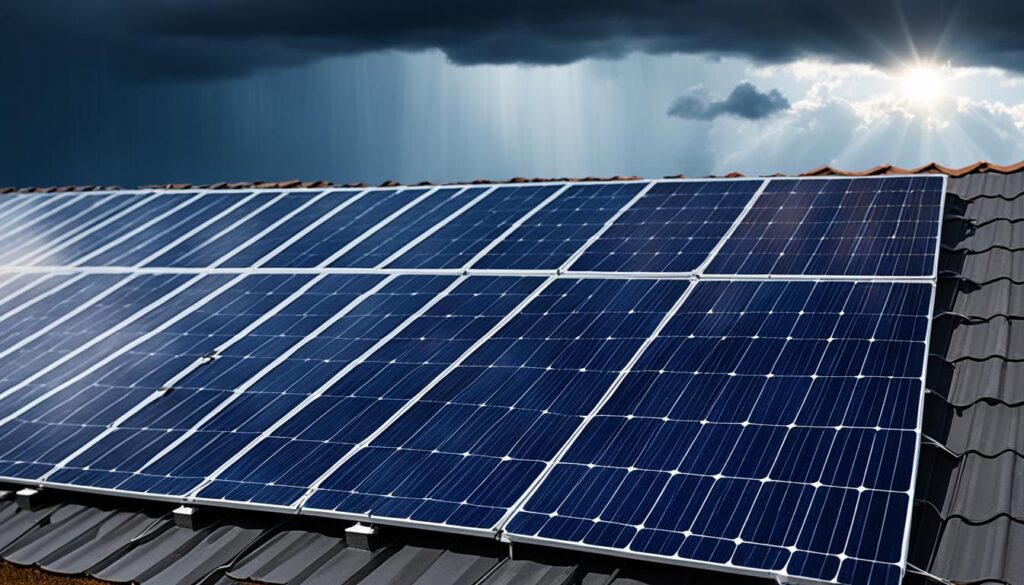
No Power Storage
If you don’t have batteries with your solar panels, you can’t save extra power made when the sun is strong. This means you won’t have power at night or on cloudy days. And that could cause your electricity to cut off, especially if you use power all the time.
In short, choosing to go without batteries with your solar panels can lead to big problems. The power supply might not be steady, and you won’t have power saved for when you really need it. This could make your power source less reliable.
Key Components Needed for a Battery-Free Setup
Starting a solar journey without batteries means knowing some very key parts. It’s all about how these pieces work together to give you power without any hitches.
Solar Panels
The heart of a solar setup is its panels. You need high-efficiency ones to change sunlight into electricity smartly. Picking the best panels shapes how well your system works and how long it lasts.
DC to DC Converter
A DC to DC converter makes sure voltages stay steady. Since solar panels get bright sunlight at different strengths, they can make power levels wobble. This tool keeps the power flow even, key for a reliable setup without batteries.
Inverter
The inverter without battery is also key. It changes stable electricity, direct current (DC), into the kind your home uses. This step is vital for letting you directly use solar power and connecting it with your home’s power.
| Component | Function | Importance |
|---|---|---|
| Solar Panels | Convert sunlight to DC electricity | Primary source of power generation |
| DC to DC Converter | Stabilize and regulate voltage levels | Ensures consistent power supply |
| Inverter | Convert DC to AC electricity | Allows use of solar power with household appliances |
How DC to DC Converters Work
DC to DC converters are key in making battery-free solar panels work well. They help keep the power at a steady level. This stable power is needed for devices to work well.
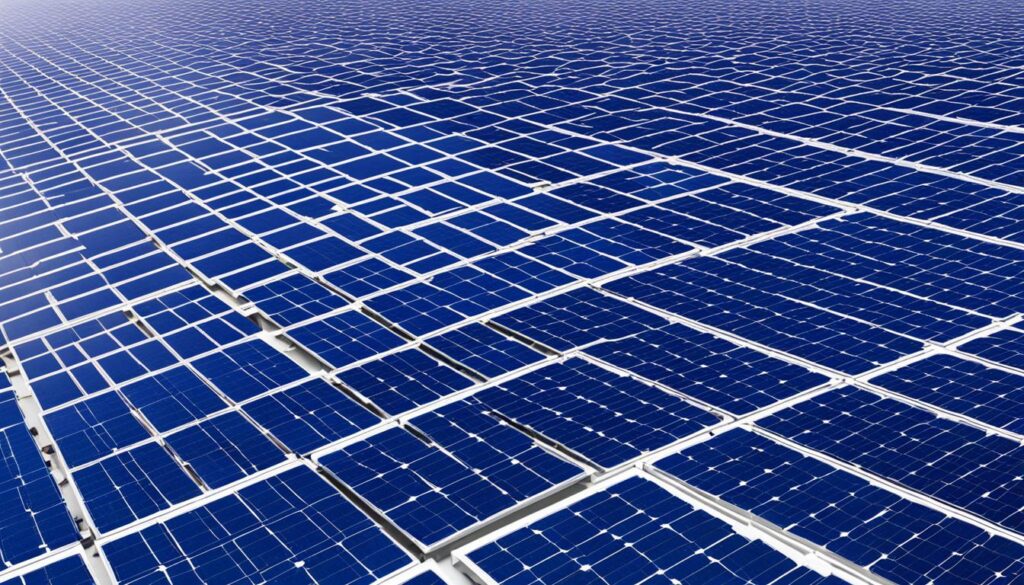
Stabilizing Voltage Levels
These converters keep the solar panel power steady. They stop the power from going up and down. This keeps our devices safe and working smoothly for a long time.
Ensuring Efficient Power Conversion
DC to DC converters mainly make power use efficient. They adjust how much voltage and current is used. This makes the solar power work better without needing batteries.
Steps to Set Up a Solar. Panel Without Battery
Setting up solar panels without a battery starts with careful planning. This helps you get the most out of solar power without using batteries. Knowing each step is key to making it work well. Here’s how to do it:
Selecting the Right Solar Panels
First, pick solar panels that match what you need. Look for ones that are efficient and last a long time. Companies like Panasonic and LG make strong panels that catch a lot of sunlight.
Choosing a Compatible DC to DC Converter
Choosing the right DC to DC converter is key. It should match your panel’s power to keep the electricity steady. Victron Energy and Morningstar Corporation make converters that work well with different solar power levels.
Proper Installation Process
Installing your solar panels takes skill and safety. Place them where they can get the most sun, usually on the roof. Connect the panels to the converter safely. Then, hook up the inverter properly to make the power ready for your home. Doing these things right makes your solar system work well and safely.
Optimizing Solar Panel Efficiency Without Batteries
Maximizing solar panel performance in a battery-free setup hinges on several key strategies. It’s important to get optimal sunlight exposure. I place panels where they get full sun all day. Analysing the site carefully and adjusting the panel angle helps get the most solar energy.
Using the best panel technology is also vital. I choose panels that are very efficient. These can produce a lot of energy without needing batteries. Monocrystalline and polycrystalline panels are known for their high efficiency.
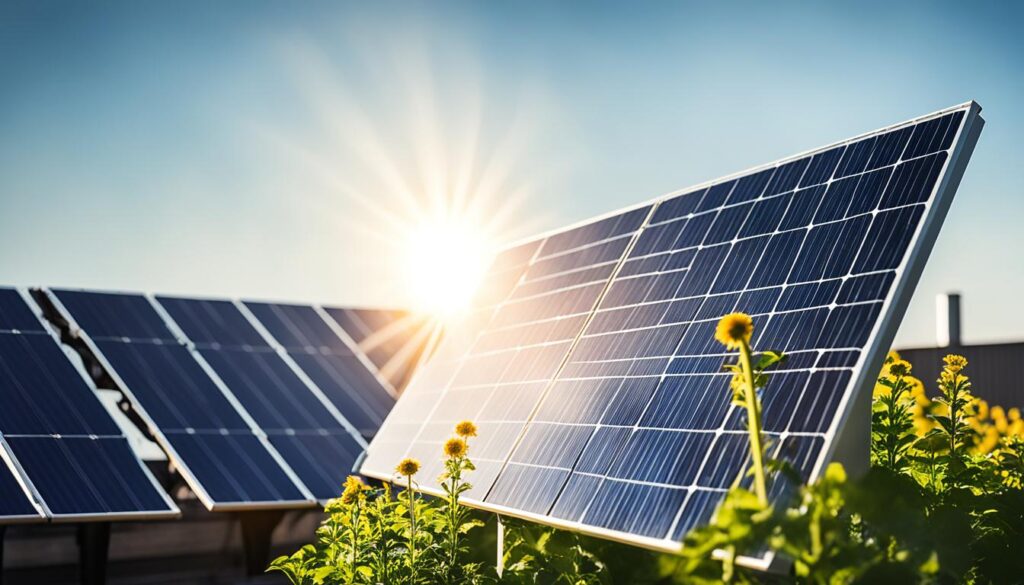
Moreover, setting up system components correctly is crucial. I pick inverters and converters that work well with the panels. This choice helps cut down on energy loss and improves the system’s performance.
Here’s how different strategies compare when enhancing solar panel efficiency:
| Strategy | Description | Impact on Performance |
|---|---|---|
| Optimal Sunlight Exposure | Placing panels in locations with maximum sunlight | Significantly increases energy generation |
| High-Performance Panels | Using panels with high efficiency rates | Boosts electricity output |
| Component Alignment | Ensuring compatibility of inverters and converters | Reduces energy losses |
By putting these steps into action, I can make the most of my solar panels even without batteries. This not only boosts efficiency but also makes my solar setup more sustainable and affordable.
Common Mistakes to Avoid in Battery-Free Systems
Opting for a solar system without batteries is both budget-friendly and eco-conscious. Yet, to keep it running smoothly, you must avoid some missteps. If you don’t, your system might not work well, or worse, it could get damaged.
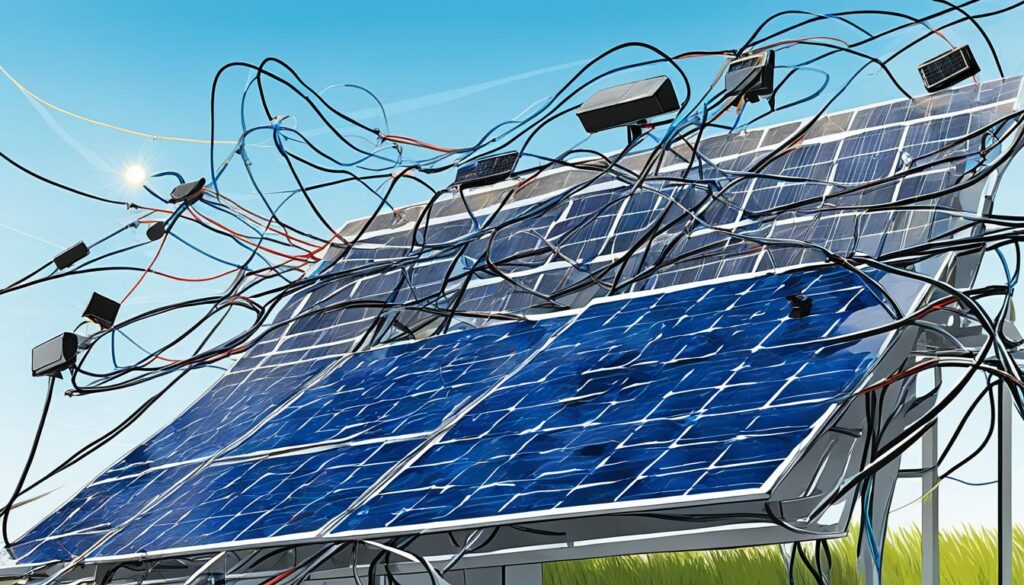
Overloading the System
One big issue for these systems is overloading. Solar panels can only make so much energy. Going beyond this limit can cause the whole system to break. You need to be careful to match the total energy your gadgets need with what your solar panels can provide. If you overestimate, your system may stop working or parts might get damaged.
Ignoring Voltage Compatibility
Getting the voltages right is also key. Different devices and systems run on different voltages. If they don’t match, you may waste energy or even harm the whole system. Always check that your solar panels’ voltage matches that of what you’re powering. Make sure everything in your system works together at the same voltage level.
Keeping a table handy can make checking these aspects easier:
| Aspect | Actions Required |
|---|---|
| System Capacity | Measure and match total power consumption with panel output |
| Voltage Compatibility | Ensure all components operate at the same voltage |
Case Studies of Successful Battery-Free Solar Installations
Real-life examples help us see how theories can work in the real world. This piece will look at successful solar setups for homes and businesses. We will cover the good and the not-so-good parts of using solar energy.
Residential Applications
Residential solar setups show us how simple homes can efficiently use solar energy. One example is a home in California where the family chose solar panels but not batteries. They reduced costs and avoided complicated maintenance. Thanks to high-quality panels and a strong DC to DC converter, the family used electricity mainly in the day.
This way, they saw a big drop in their power bills. They used energy wisely, focusing on daytime for energy-hungry activities. The effort was a hit, saving money and being kind to nature.
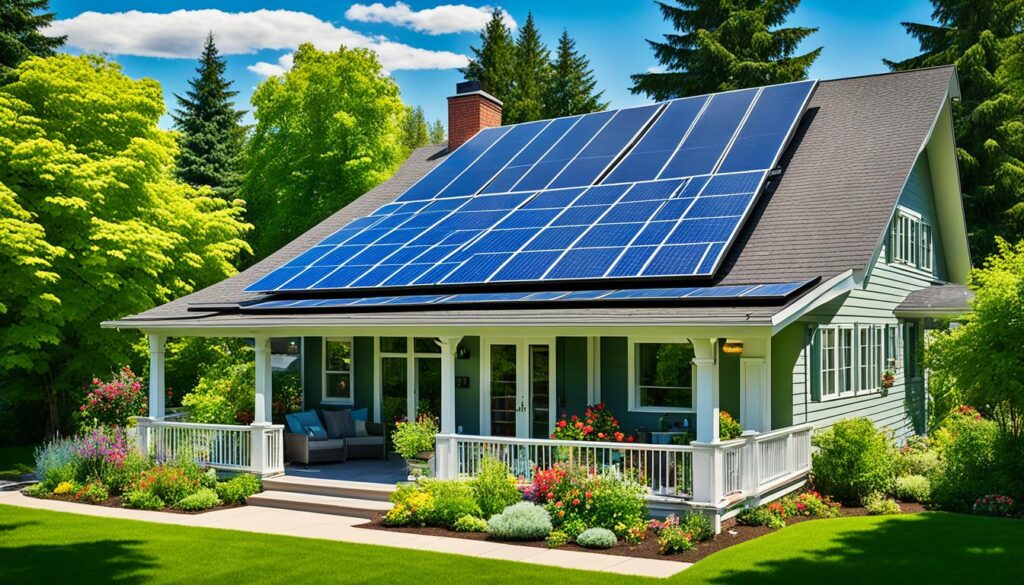
Commercial Deployments
For big operations, like stores, solar power offers different pros and cons. A store in Texas went all in on solar panels, skipping the need for batteries. They set up lots of solar panels matched with top-notch inverters. This cut a good share of their daily electricity use.
It shows big companies can save big and help the planet with solar power. Yet, keeping these systems at peak under all weather can be tough. It needs regular check-ups and tweaks to keep running smoothly.
| Aspect | Residential Applications | Commercial Deployments |
|---|---|---|
| Primary Goal | Reduce costs and maintenance | Offset daily electricity consumption |
| Equipment Used | High-efficiency panels, DC to DC converters | Advanced inverters, extensive panel arrays |
| Challenges | Maximizing efficiency during daylight | Maintaining consistent performance |
| Benefits | Cost-effective, environmentally friendly | Reduced energy costs, sustainable |
How to Use Solar Panel Directly Without Battery
You can use the sun’s power without storing it in batteries. Just connect a solar panel directly. This needs to match the power it creates with what the devices need. We do this with certain ways and tools. It becomes a reliable choice.
Direct Connection Methods
Setting up a direct connection means what your solar panels make runs your stuff right away. This helps your tools and gadgets work using solar power. Matching the panel’s output to what you need is key, especially during the sunniest times. Extra power can even go back into the grid, depending on where you live.
The Role of Inverters in Battery-Free Systems
In these setups, inverters are crucial. They change the solar panel’s direct current (DC) into what most things at home use, alternating current (AC). Inverters are smart. They keep the power steady, even if the sun’s not shining as brightly. This makes using solar power directly at home much better.
Maintenance Tips for Solar Panels Without Batteries
It’s key to keep your battery-free solar panel system in check for top performance and a long life. Since there are no batteries, maintaining the direct solar power conversion is crucial. This involves keeping the system clean and checking its performance often.
Regular Cleaning
Cleaning your solar panels regularly is vital. Dust and debris can gather on them, which reduces their power absorption. Ideally, clean them twice a year. More cleaning might be needed if you’re in a dusty or pollen-filled place.
- Use soft, non-abrasive materials to avoid damaging the panel surface.
- Opt for water and mild soap solutions; avoid harsh chemicals.
- Schedule cleanings during early morning or late afternoon to prevent cleaning in intense sunlight, which can cause streaking.
Monitoring System Performance
It’s key to keep an eye on your solar system to catch problems early. Regular checks ensure your panels are working at their best. This way, you get the power output you expect.
| Feature | Action Required | Frequency |
|---|---|---|
| Inspect Connections | Check for loose or frayed wires | Monthly |
| Evaluate Output | Compare actual vs. expected performance | Quarterly |
| Update Software | Install firmware updates for monitoring devices | Annually |
Following these maintenance tips and keeping an eye on your solar system is super important. Doing so ensures you get the most out of your battery-free solar setup. It also helps avoid power disruptions.
Conclusion
Direct use of solar panels, without batteries, is a new way to use solar energy. It’s not the usual method but has its perks. It lowers costs and upkeep. You can make the most of the sun’s power during the day.
This way of using solar panels is all about using electricity right away. It’s perfect for those wanting to be greener. Choosing the best solar panels, converters, and inverters is key. This ensures you always have power. It’s good for the planet and easy on the wallet too.
Going battery-free shows you care about using solar in a smart way. As tech gets better, these options will open up to more people. It’s a smart choice for clean, affordable power. It means moving towards using the sun’s energy better, for a sustainable tomorrow.
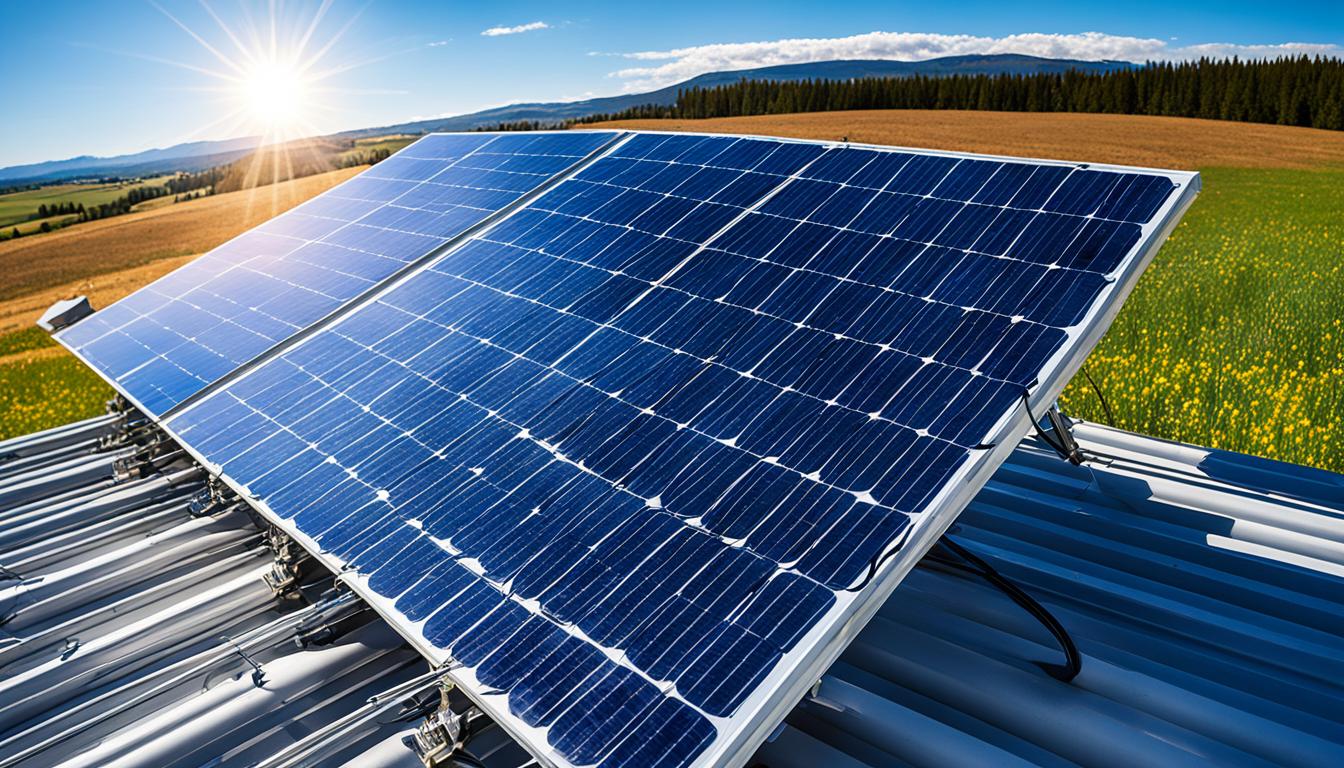



Interesting read, but have you considered the lost efficiency when using solar panels directly? I know batteries are a pain, but they play a crucial role in energy storage and use during sunless hours. It seems too optimistic to completely disregard their importance. What about continuous power supply during nighttime or cloudy days?
Interesting read, but have we considered how the lack of batteries could impact the consistency of power supply? Especially during cloudy days or winter season. Also, isnt the batterys role in storing excess energy crucial to maximize efficiency? Just throwing some thoughts out there.
Interesting read, but Im not entirely sold. Without batteries, what happens at night or during cloudy days? Isnt the batterys role to store excess power for such instances? Im all for innovation, but this seems like a step back. Solar energy is about being sustainable and independent, isnt it?
I think using solar panels directly without batteries sounds convenient, but what about storing excess energy for cloudy days or at night? Isnt that important for a reliable power supply?
I think relying solely on solar panels without batteries is risky. What if the sun isnt shining when you need power? Batteries provide backup and stability. What do you all think?
Solar panels with batteries are essential for reliable energy storage. Dont cut corners on backup.
Interesting read, but isnt a battery-less system risky? What happens at night or during extended cloudy periods? Just food for thought.
Interesting read, but arent we oversimplifying the risks of direct solar usage? What about night usage or cloudy days? Just food for thought.
Cloudy days and nights, ever heard of energy storage solutions? Solars future is bright, literally!
Interesting read but isnt the battery crucial for storing excess power? What happens during cloudy days or at night? Just curious.
Interesting read, but isnt it risky to rely on solar without batteries? What about night usage or cloudy days? Just a thought.
Interesting read, but isnt it risky to run solar panels without batteries? What about nights or cloudy days? Just food for thought!
Interesting read, but isnt it kinda risky to rely solely on solar without batteries? What about overcast days or night-time?
Interesting concept, but what if theres a power outage? Can solar panels without batteries handle such a situation?
Interesting read, but arent batteries essential for storing excess energy? What happens during non-sunny periods without them? Sustainability vs. practicality?
Interesting read, but isnt the inconsistency of sunlight a major downside for direct solar panel usage?